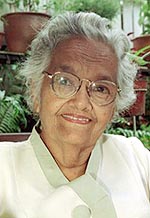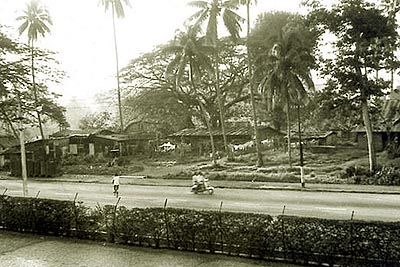|
Bukit
Bintang once a sleepy hollow
By C. Celestine
THE
Bukit Bintang of today is a bustling commercial haven with
shopping malls touting designer labels, five-star hotels
and dressy sidewalk cafes, restaurants, bars and nightspots.
Elena
Maude Cooke, 78, a former student and headmistress of Bukit
Bintang Girls School (BBGS) recalled the time when things
were far less lively.
It was,
for much of the last century, a sleepy hollow where much
of the activities centred around the school.
"It
was a sparsely populated area on the outskirts of KL with
few landmarks except for the school, on the the northern
fringe of Jalan Bukit Bintang and Jalan Sultan Ismail,''
said Cooke, or Ms Cooke to thousands of her students, during
a recent interview at her home in Ampang Hilir.
The
school had its humble beginnings in Brickfields when it
was then known as the Chinese Girls School, but moved to
this location in 1930 with 250 students.
"It
was founded in 1893 by a missionary from the Brethern movement,
Betty Langlands, who wanted to give girls the same educational
opportunities that the boys had,'' she said.
The
land fronting the school, where Star Hill is presently located,
was vacant.
A few
years after the school was established, huts built by the
Chinese community sprang up on the vacant plot.
Later
in the 1950s and 1960s, more houses were built from Jalan
Gading to Jalan Imbi, which soon turned the area into a
housing estate.
There
were hardly any supermarkets and shops in the area, recalls
Cooke.
"Those
who could afford it did their shopping in Whiteaways or
Robinson's but there were sundry and textile shops owned
by locals like Naina Mohamad Ali,'' she said.
People
used to have their groceries delivered on bicycles and later
motorcycles, she said.
There
were many food stalls which later turned into cafes and
itinerant vendors made their rounds selling iceball, nyonya
cakes and satay.
She
does not remember the Bukit Bintang Park very well except
that it used to have Chinese opera, a dance hall and a boxing
ring besides plenty of food stalls.
"But
it never really recovered after the Second World War. It
started to go downhill and by the late 1960s it closed down,''
Cooke said.
Cooke
had originally intended to do medicine after completing
her Senior Cambridge and had obtained a Straits scholarship
to the Medical College in Singapore in 1938.
But
the War came and she returned home in 1942 "to plant tapioca
and live under Japanese rule''.
When
the War ended, the scholarship was no longer available and
she started teaching at her alma mater in 1945.
 Cooke...wanted
to do medicine after Senior Cambridge. Cooke...wanted
to do medicine after Senior Cambridge.
There
were 365 girls studying at BBGS then. In 1958, she became
its first local headmistress and was known to be a strict
disciplinarian.
Cooke
spoke of a time when dedicated teachers knew each student
and visited homes to get to know the families.
And
there was a waiting list for those wishing to send their
girls to the school.
"People
realised the school maintained high standards of discipline
with care.
"Many
who did not live around the area also insisted on sending
their daughters to the school,'' she said
In the
1980s, development crept in and exposed many colonial schools
to heavy traffic and pollution, she said.
"Surrounded
by shopping malls and entertainment centres, the old location
made it difficult for many students to concentrate on their
studies and travel to school.''
The
BBGS was relocated to Taman Shamelin in Cheras late last
year and renamed SM Seri Bintang (Utara).
The
present building at the end of Jalan Bukit Bintang is unoccupied.
It has been sold to a developer for a highrise project.
Cooke
enjoys living in the city but despite the massive development
there is much room for improvement in public amenities.
Citing
the condition of toilets, as an example, she said it showed
an appalling lack of civic-mindedness on the part of the
public.
"Any
tourist to a country would first look at this and if it
is not up to the mark, no amount of natural attractions,
will bring them here.''
Safety
in Kuala Lumpur was also deteriorating.
It had
become especially unsafe for elderly people to carry cash
as muggings and snatchings were becoming common, she added.
In conclusion,
Cooke pointed out that town planners should consider the
architectural heritage of a country, so schools would not
be swallowed up by skyscrapers and forced to relocate.
"Old
schools could be converted into cultural or art centres
which are more in harmony with its architecture,'' she added.

EARLY
20th CENTURY... the area fronting the Bukit Bintang Girls
School was a vacant plot which was gradually populated by
the Chinese community.
|
